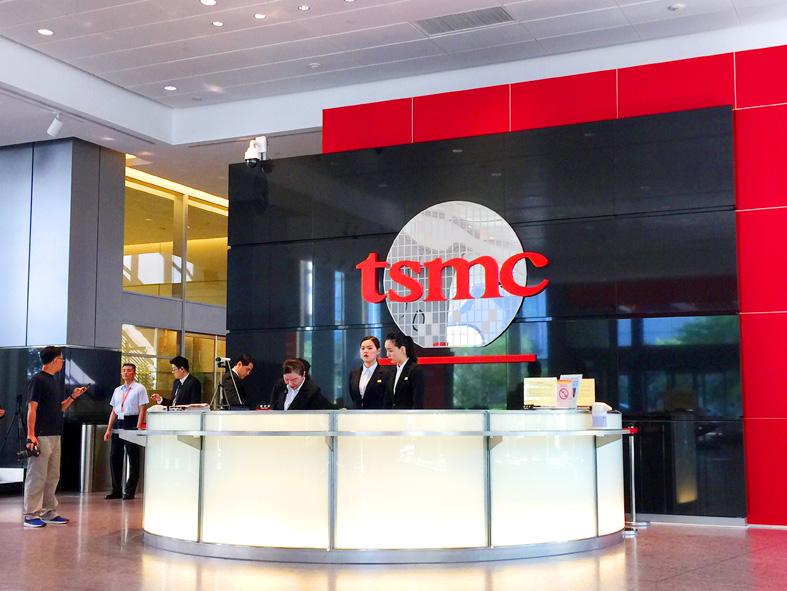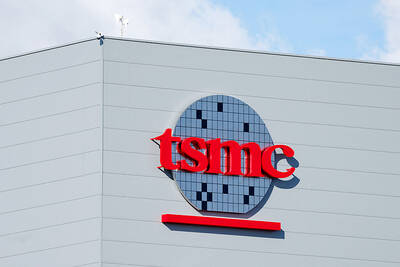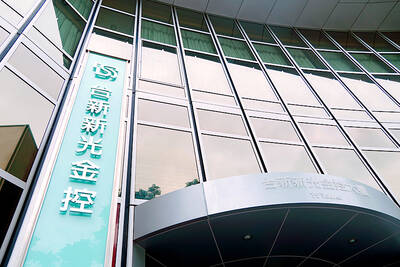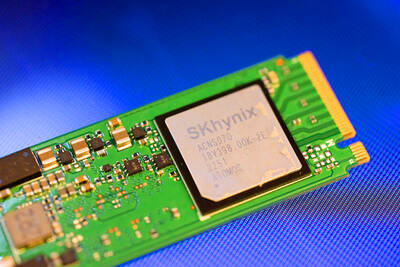To finance production expansions, Taiwan Semiconductor Manufacturing Co (TSMC, 台積電) would issue up to NT$120 billion (US$4.13 billion) in bonds, the company said on Friday.
The world’s largest contract chipmaker is to initially issue a batch of NT$21.1 billion in three unsecured corporate bond tranches: a five-year tranche of NT$4.8 billion with a coupon rate of 0.5 percent, a seven-year tranche of NT$11.4 billion with 0.55 percent and a 10-year tranche of NT$4.9 billion with 0.6 percent, TSMC said.
The plan, approved by a board meeting last month, would increase production capacity through new facilities and equipment upgrades, and pollution prevention measures at its fabs, it said.

Photo: Grace Hung, Taipei Times
Capital Securities Corp (群益證券) would serve as the lead underwriter of the bond sale, TSMC said.
In an investors’ conference held in mid-January, TSMC vice president and chief financial officer Wendell Huang (黃仁昭) said that the company would spend US$25 billion to US$28 billion on capital expenditure this year, a record for the chipmaker.
US-based advisory firm IC Insights said that governments in the US, EU and China would each have to spend at least US$30 billion per year for five years to catch up with TSMC and South Korea’s Samsung Electronics Co.
The combined capital expenditure of TSMC and Samsung is forecast to total at least US$55.5 billion this year, making it unlikely for any other chipmaker to rival them in spending, IC Insights said, adding that the two firms are expected to further widen their technology gaps with their competitors.
However, capacity shortages in the chip industry have over the past few months disrupted production at smartphone makers and automakers.
On Wednesday, Samsung said that its smartphone production in the second quarter could be affected by global chip shortages.
Seoul-based NH Investment and Securities Co said in a note on Thursday that the situation would start improving in the second half of this year, as operations at TSMC fabs in Taiwan and a Samsung fab in Austin, Texas, would return to normal, and new facilities of both companies would assume operations.

On Tuesday, US President Donald Trump weighed in on a pressing national issue: The rebranding of a restaurant chain. Last week, Cracker Barrel, a Tennessee company whose nationwide locations lean heavily on a cozy, old-timey aesthetic — “rocking chairs on the porch, a warm fire in the hearth, peg games on the table” — announced it was updating its logo. Uncle Herschel, the man who once appeared next to the letters with a barrel, was gone. It sparked ire on the right, with Donald Trump Jr leading a charge against the rebranding: “WTF is wrong with Cracker Barrel?!” Later, Trump Sr weighed

Taiwan Semiconductor Manufacturing Co (TSMC, 台積電) secured a record 70.2 percent share of the global foundry business in the second quarter, up from 67.6 percent the previous quarter, and continued widening its lead over second-placed Samsung Electronics Co, TrendForce Corp (集邦科技) said on Monday. TSMC posted US$30.24 billion in sales in the April-to-June period, up 18.5 percent from the previous quarter, driven by major smartphone customers entering their ramp-up cycle and robust demand for artificial intelligence chips, laptops and PCs, which boosted wafer shipments and average selling prices, TrendForce said in a report. Samsung’s sales also grew in the second quarter, up

HEADWINDS: Upfront investment is unavoidable in the merger, but cost savings would materialize over time, TS Financial Holding Co president Welch Lin said TS Financial Holding Co (台新新光金控) said it would take about two years before the benefits of its merger with Shin Kong Financial Holding Co (新光金控) become evident, as the group prioritizes the consolidation of its major subsidiaries. “The group’s priority is to complete the consolidation of different subsidiaries,” Welch Lin (林維俊), president of the nation’s fourth-largest financial conglomerate by assets, told reporters during its first earnings briefing since the merger took effect on July 24. The asset management units are scheduled to merge in November, followed by life insurance in January next year and securities operations in April, Lin said. Banking integration,

LOOPHOLES: The move is to end a break that was aiding foreign producers without any similar benefit for US manufacturers, the US Department of Commerce said US President Donald Trump’s administration would make it harder for Samsung Electronics Co and SK Hynix Inc to ship critical equipment to their chipmaking operations in China, dealing a potential blow to the companies’ production in the world’s largest semiconductor market. The US Department of Commerce in a notice published on Friday said that it was revoking waivers for Samsung and SK Hynix to use US technologies in their Chinese operations. The companies had been operating in China under regulations that allow them to import chipmaking equipment without applying for a new license each time. The move would revise what is known